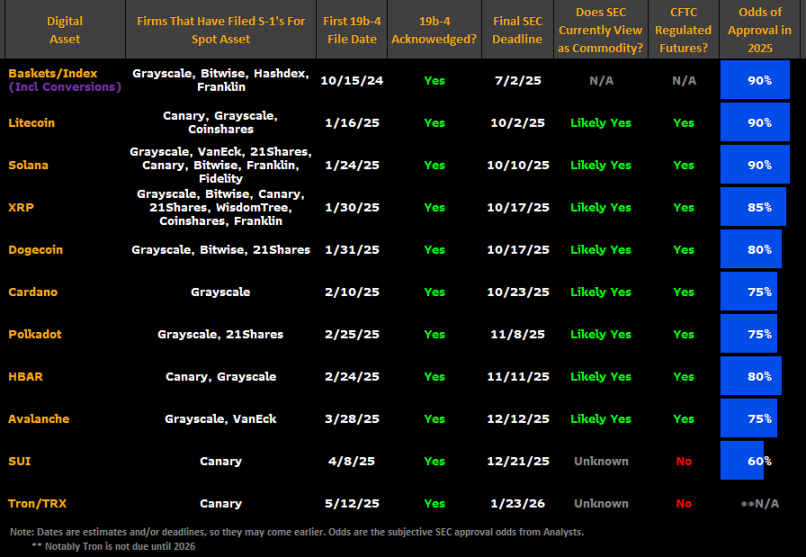The Solana spot ETF is making substantial progress again, with the SEC focusing on evaluating staking and redemption mechanisms
Words: Nancy, PANewsAt
a time when the Solana ecosystem is at a low mood, an ETF news has once again ignited the market's optimistic expectations. On June 11, the SEC asked potential Solana spot ETF issuers to update their S-1 filings. This move is seen by the market as a turning signal that Solana ETF has entered the substantive review stage, releasing a positive signal from the regulator. Driven by this, the market's expectation of an official approval in July has rapidly increased, and the Solana ecosystem has ushered in a general upward trend.
Solana spot ETF approval accelerated, SEC focuses on physical redemption and staking mechanism
According to Blockworks, multiple people familiar with the matter revealed that the SEC has notified a number of issuers planning to launch Solana spot ETFs to submit updated S-1 registration statement documents in the coming week. This means that a number of issuers intending to launch Solana spot ETFs have been notified to file updated S-1 registration statements in the coming week.
TheSEC will provide review feedback within 30 days of the submission of the S-1 filing, and the document update focuses on changes to the language of physical redemptions and the handling of the staking mechanism, both of which are also becoming a core focus in the approval process for crypto spot ETFs, the sources noted.
In the design of crypto asset ETFs, physical redemption means that investors can exchange ETF shares back to the corresponding underlying asset (such as SOL) instead of cash. When the SEC reviews the S-1 filing, it will focus on whether the issuer's description of how the redemption in kind is executed, how the value of the asset is calculated, and whether the redemption of some or all of the assets in cash is sufficiently clear, legal, compliant, and actionable. The setting of this mechanism is directly related to the market transparency, liquidity and arbitrage efficiency of ETFs, and its compliance statement has also become an important basis for the SEC to evaluate whether ETFs are suitable for retail and institutional investors.
staking mechanism is another focus of market attention, staking is a native asset appreciation means of PoS public chains such as Solana, which can bring on-chain income to holders. Staking Rewards data shows that as of June 11, Solana's staking rate was 65.44% and the staking yield was 7.56%, more than double that of Ethereum (3.13%). In the past, the SEC has repeatedly avoided the staking clause in the approval of Ethereum ETFs, fearing that it may involve the attributes of securities income. But during negotiations with BlackRock for an Ethereum spot ETF in May, the SEC relented and began to accept the inclusion of staking functionality under certain conditions. According to a person familiar with the matter, the SEC is currently open to including a staking mechanism in Solana's spot ETF, so it requires issuers to have sufficient legal clarity and implementation rules.
Since Grayscale first filed 19b-4 filings for the Solana spot ETF in 2024 and was officially accepted by the SEC in February this year, the Solana ETF has entered a substantial regulatory process. Although the SEC again announced at the end of May that it would delay the approval of some Solana ETFs, citing the need for "more time to evaluate legal and policy issues", the revised S-1 directive sends an important signal that regulators no longer reject the viability of Solana ETFs and have shifted from a veto stance to a rule-playing and detail-polishing stage.
So far, Fidelity, Franklin Templeton, VanEck, Bitwise, Canary Capital, 21Shares, and Grayscale have all applied for Solana spot ETFs.
Affected by this news, CoinGecko data shows that the Solana ecological token has seen a general rise, and the SOL price once hit a new high this month. Previously, due to factors such as the blood-sucking effect of Pump.fun issuance and the diversion of other on-chain liquidity incentives, Solana's participation in the popularity has dropped significantly compared with the beginning of the year.
As early as July, with a 90% chance
ofapprovalAfter the successful landing of Bitcoin and Ethereum spot ETFs, the focus of market attention is quickly shifting to the potential targets of the next round of crypto spot ETFs.
Solana is the third crypto asset to make a spot ETF application after Bitcoin and Ethereum. According to Blockworks, citing people familiar with the matter, judging from the latest ETF application document update cadence, the Solana spot ETF is expected to be approved in the next 3 to 5 weeks, that is, it could be approved as soon as July, which is earlier than the end of the second half of the year that was widely expected by the market.
James Seyffart, an analyst at Bloomberg ETF, said in his latest forecast that the product could be approved this year, or even as early as July. "We think the SEC may be processing the 19b-4 filings for Solana and staked ETFs earlier than originally planned," he said. Issuers and industry participants have likely been working with the SEC and its cryptoasset task force to develop the rules, but the deadline for the SEC to make a final decision on these applications is still in October this year."
Solana was considered to have met the key prerequisites for approval. James Seyffart added that Solana's ETF application with XRP has now been approved for a derivatives ETF, which paves the way for the approval of spot ETFs.
In fact, in March this year, Volatility Shares launched two Solana futures ETFs, which are the first L1 public chain projects to be licensed as a U.S. futures ETF after Bitcoin and Ethereum, which are regarded as important indicators to assess the maturity of the spot ETF market. This path highly echoes the pace of Bitcoin and Ethereum spot ETFs, which first "explore" by futures ETFs and then promote the landing of spot products.
Outside of the U.S., Canada's Toronto Stock Exchange launched four Solana spot ETFs in April with support for staking. This product innovation not only shows its attractiveness to institutional investors, but also creates indirect pressure on the SEC in an international regulatory dimension.

In James Seyffart's latest prediction of the approval probability of crypto spot ETFs, Solana and Litecoin are in the first echelon in terms of approval probability. Among them, Litecoin and Solana have a 90% chance of being approved; XRP has an 85% chance of approval; Dogecoin, HBAR are expected to pass with an 80% probability; Cardano, Polkadot, Avalanche are expected to pass with a 75% chance of passing; SUI expects a 60% chance of passing.
While Solana already meets most of the key requirements for approval as a U.S. spot ETF, the SEC has previously classified SOL as an "unregistered security" in its lawsuit against Coinbase and Binance. While some of these lawsuits have been suspended or withdrawn, the security labels have not been formally clarified or adjudicated, posing a potential obstacle.
